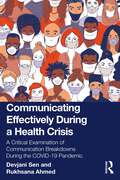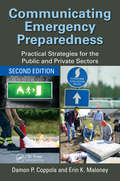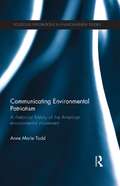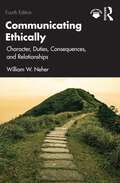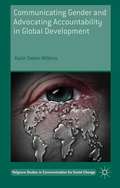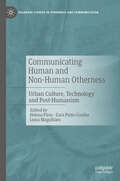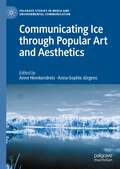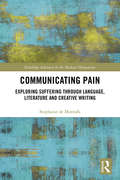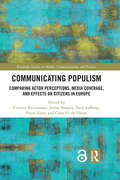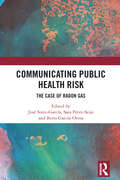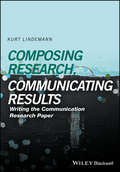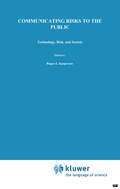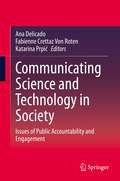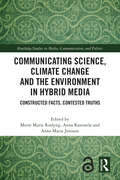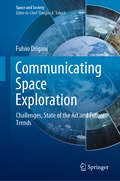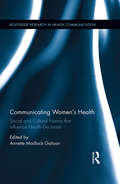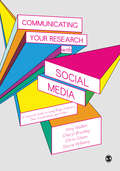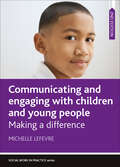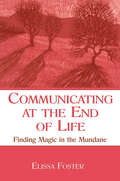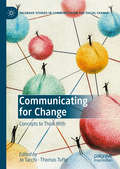- Table View
- List View
Communicating Differences: Culture, Media, Peace and Conflict Negotiation
by Sudeshna Roy Ibrahim ShawThis volume captures the essence of how we communicate differences in relationships, between and across cultures, in organizations, through education and in moments of local and global conflict and crisis that demonstrates the importance and viability of approaching peace and conflict communication from various fields within communication studies.
Communicating Effectively During a Health Crisis: A Critical Examination of Communication Breakdowns During the COVID-19 Pandemic
by Rukhsana Ahmed Devjani SenExploring how and why communication breakdowns occur during pandemics and world disasters, this book offers solutions for improving communication and managing future public health crises.A compilation of evidence-based lessons learned, this book shows how to effectively convey critical lifesaving information during a pandemic. It assesses how trust in leaders and governments during a public health crisis is formed and the impact this has on how information is perceived by the public. Using the COVID-19 pandemic as a case study, the book demonstrates how informative policy decisions and health risk messages can be better communicated for the handling of future pandemics. At a macro-level, the book looks at issues concerning situational awareness, how different countries managed or mismanaged the pandemic, and the lessons readers can learn from those occurrences. At a micro-level, it examines individual differences in public health message perceptions and corresponding actions taken or not taken.An interdisciplinary critique of the delivery and reception of messages during global disasters, this text is suitable for undergraduate and graduate courses in Communication Studies, Health Communication, Risk Communication and Public Health, Psychology, Sociology, and Disaster Management.
Communicating Effectively with People with a Learning Disability
by Sue ThurmanIf you are working within the learning disability sector and studying for the QCF Diploma in Health and Social Care, you will find this book invaluable in helping you to achieve the unit on Communicating effectively. It explain how communication affects all aspects of your work, including relationships, and provides guidance on how to overcome barriers to good communication. The book is easy to navigate, with each chapter covering one of the learning outcomes within the unit. Each chapter begins with an example taken from real people's stories and lots of activities, photographs and other illustrations are included throughout.
Communicating Emergency Preparedness: Practical Strategies for the Public and Private Sectors, Second Edition
by Damon P. Coppola Erin K. MaloneyThis fully revised edition of Communicating Emergency Preparedness: Practical Strategies for the Public and Private Sectors includes timely case studies, events, and references to articles and opinions about the direction of emergency preparedness communication. The authors draw upon their professional endeavors to inject a new sense of practicality to the text. New images displaying emergency preparedness campaigns are used to further illustrate the materials being presented. For instructors and practitioners alike, this book continues to provide the how-to instruction that is often required, and will only improve upon the success of the first edition in doing so.
Communicating Environmental Patriotism: A Rhetorical History of the American Environmental Movement (Routledge Explorations in Environmental Studies)
by Anne Marie ToddEnvironmental patriotism, the belief that the national environment defines a country’s greatness, is a significant strand in twentieth century American environmentalism. This book is the first to explore the history of environmental patriotism in America through the intriguing stories of environmental patriots and the rhetoric of their speeches and propaganda, The See America First movement began in 1906 with the aim of protecting and promoting the landscapes of the American West. In 1908, Gifford Pinchot and President Theodore Roosevelt hosted the White House Conservation Conference to promote the wise use of natural resources for generations of Americans. In 1912, Pittsburgh’s smoke investigation condemned the effects of coal smoke on the city’s environment. In World War II, a massive propaganda effort mobilized millions of Americans to plant victory gardens to save resources for the war abroad. While these may not seem like crucial moments for the American environmental movement, this new history of American environmentalism shows that they are linked by patriotism. The book offers a provoking critique of environmentalists’ communication strategies and suggests patriotism as a persuasive hook for new ways to make environmental issues a national priority. This original research should be of interest to scholars of environmental communication, environmental history, American history and environmental philosophy.
Communicating Ethically: Character, Duties, Consequences, and Relationships
by William W. NeherThis thoroughly updated fourth edition provides a broad introduction to the major theoretical perspectives on the ethics of communication. It brings together classical and modern theories of ethical philosophy to address issues at play in specific careers and domains throughout the field. By incorporating a simple framework for ethical reasoning, readers are able to develop their own understanding of various criteria for making ethical judgments. The book applies ethical theories, such as virtue and dialogical ethics, to interpersonal, organizational, political, social media, and digital communication contexts. This edition contains expanded coverage of contemporary and non-Western issues and theories. This includes the Black Lives Matter and #MeToo movements, "fake news", new technologies such as "Deepfake" videos, Confucian ethics, and Igbo ethics. It also includes a new chapter on the ethics of communicating scientific and medical risks. This book serves as a core textbook for undergraduate courses in Communication and Media Ethics and can also be used as a supplemental resource for field-specific courses in Strategic Communication, Interpersonal Communication, and Public Relations. Online resources for instructors include sample syllabi, sample assignments, and a test bank for multiple choice and essay questions. They are available at www.routledge.com/9781032507798.
Communicating Fashion Brands: Theoretical and Practical Perspectives
by Emily Huggard Jon CopeThis book demonstrates how fashion brands communicate, why the practice is significant within wider society and how it can be perceived as culturally meaningful. Enabling readers to connect the tools and techniques of communication with their theoretical underpinnings and historical antecedents, the book shows how these methods can be applied in practice. The authors utilise social, consumer and cultural theory, and frameworks rooted in psychology, sociology and economics, as mechanisms to analyse and deconstruct current communication strategies used by fashion brands. The book presents insights and strategies for communicating authentic values, conveying a clearly defined aesthetic and visual language and generating shareable content that resonates with audiences. With insights into strategies used by brands including Burberry, Gucci, Dior, COS, Rapha, Warby Parker and Maryam Nassir Zadeh, each chapter outlines ways of maintaining relevant and consistent brand narratives in the 21st century. From how to sustain a dialogue with a brand’s community, to the use of brand collaboration, co-creative storytelling and fashion spaces, the book aims to develop reflective communication practitioners who have a deep understanding of the cultural landscape, brand strategy and industry innovation. Written for scholars and practitioners, this book is a valuable blend of theory and practice across the fields of fashion, communication and branding.
Communicating Gender and Advocating Accountability in Global Development (Palgrave Studies in Communication for Social Change)
by Karin WilkinsCase studies of micro-enterprise, girls' education, and population programs suggest that our discourse limits our potential to conceive of development, communication, and gender outside of neoliberal ideologies. Advocacy for global social justice demands a different accountability through critical research.
Communicating Human and Non-Human Otherness: Urban Culture, Technology and Post-Humanism (Palgrave Studies in Otherness and Communication)
by Luísa Magalhães Helena Pires Zara Pinto-CoelhoThis book approaches the generic theme of the series – studies in otherness and communication – from the perspectives of urban culture and posthumanist studies. It brings together a broad variety of essays examining the different ways in which agency reinvents itself, whether in the urban space, through the multiple forms and devices of art and culture, or through the relationship with technology and the surrounding environment, as a result of the contemporary conditions of post-humanism and the anthropocene. The sense of becoming other is added through a new paradigm that combines 1) a theoretical-essayistic mode, supported by illustrative cases with 2) the description of artistic processes and literary production. The essays are written by an international group of humanities and social sciences scholars/artists, consisting of Cristina Álvares, Pier Luca Marzo, Edwige Armand, Chiara Mengozzi, Ricardo G. Soeiro, Panagiotis Ferentinos, Mónica Aubán Borrell, Luis Campos Medina, Bill Psarras, Cíntia Sanmartin Fernandes, Micael Herschmann, Mitja Velikonja, Teresa Mora and Tiago Porteiro.
Communicating Ice through Popular Art and Aesthetics (Palgrave Studies in Media and Environmental Communication)
by Anna-Sophie Jürgens Anne HemkendreisThis book brings together the perspectives of eminent and emerging scholars from fields as varied as science communication, art history, pop cultural studies, environmental studies, sciences studying ice and artists to explore the power of (popular) arts and aesthetics to communicate ice research and the urgency of environmental action. Examining the aesthetic strategies employed in images, (popular) visual fiction and narratives to convey meaning and awareness – and how they can be made fruitful for science communication – the project will generate new perspectives on how our collective environmental responsibility can be addressed and communicated across disciplines and divers audiences. In doing so, the volume will illuminate the cultural power of ice research and contribute to a better understanding of the cultural work that emerges from our ecological crisis.
Communicating Pain: Exploring Suffering through Language, Literature and Creative Writing (Routledge Advances in the Medical Humanities)
by Stephanie Potocka de MontalkCombining critical research with memoir, essay, poetry and creative biography, this insightful volume sensitively explores the lived experience of chronic pain. Confronting the language of pain and the paradox of writing about personal pain, Communicating Pain is a personal response to the avoidance, dismissal and isolation experienced by the author after developing intractable pelvic pain in 2003. The volume focuses on pain's infamous resistance to verbal expression, the sense of exile experienced by sufferers and the under-recognised distinction between acute and chronic pain. In doing so, it creates a platform upon which scholarly, imaginative and emotional quotients round out pain as the sum of physical actualities, mental challenges and psychosocial interactions. Additionally, this work creates a dialogue between medicine and literature. Considering the works of writers such as Harriet Martineau, Alphonse Daudet and Aleksander Wat, it enables a multi-genre narrative heightened by poetry, fictional storytelling and life-writing. Coupled with academic rigour, this insightful monograph constitutes a persuasive and unique exploration of pain and the communication of suffering. It will appeal to students and researchers interested in fields such as Medical Humanities, Autobiography Studies and Sociology of Health and Illness.
Communicating Populism: Comparing Actor Perceptions, Media Coverage, and Effects on Citizens in Europe (Routledge Studies in Media, Communication, and Politics)
by Claes H. de Vreese James Stanyer Carsten Reinemann Frank Esser Toril AalbergThe studies in this volume conceptualize populism as a type of political communication and investigate it comparatively, focusing on (a) politicians’ and journalists’ perceptions, (b) media coverage, and (c) effects on citizens. This book presents findings from several large-scale internationally comparative empirical studies, funded by the European Cooperation in the field of Scientific and Technical Research (COST), focusing on communication and the media within the context of populism and populist political communication in Europe. The studies are based on comparative interview studies with journalists and politicians, a large-scale comparative content analysis, and a comparative cross-country experiment using nationally representative online-surveys over 15 countries. The book also includes advice for stakeholders like politicians, the media, and citizens about how to deal with the challenge of populist political communication. This enlightening volume is ‘populist’ in the best sense and will be an essential text for any scholar in political science, communication science, media studies, sociology and philosophy with an interest in populism and political communication. It does not assume specialist knowledge and will remain accessible and engaging to students, practitioners and policymakers.
Communicating Public Health Risk: The Case of Radon Gas
by Sara Pérez-Seijo Berta García-Orosa José Sixto-GarcíaThis important volume provides not only an in-depth analysis of those risk communication strategies currently used to inform and educate the public around key health issues, but also the risks and effects of radon, a natural but carcinogenic gas that so far has seen relatively little wider coverage. As the leading cause of lung cancer worldwide after smoking, radon is an important yet hidden public health issue, but informing and educating the public about its hazards and dangers is far from straightforward. As well as offering a detailed overview of issues around radon itself, the book asserts that public health communication should be dialogic and interactive, culturally tailored to specific populations to ensure people comprehend and appreciate risk to themselves and their environments. The challenges are, of course, significant in a pluralistic media landscape where disinformation and misinformation threaten the integrity of any message sent. Featuring chapters from researchers across a range of disciplines, this enlightening book will interest students, scholars and professionals working in Public Health, Environment Health and Communication Studies.
Communicating Research, Communicating Results: Writing the Communication Research Paper
by Kurt LindemannComposing Research, Communicating Results: Writing the Communication Research Paper provides communication students with the knowledge and necessary tools to compose a variety of course-required papers that are scholarly, accessible, and well-written. The first work of its kind to take students from brainstorming to outlining to sentence and paragraph construction to paper presentation, drawing on student-written examples Easy-to-understand explanations of passive voice, point of view, commonly accepted citation styles, and more, with current and relatable student-written examples Covers common writing assignments in communication and related courses, including the literature review, application paper, and empirical research paper Four pedagogical features enhance comprehension and support learning: "Write Away" quick exercises, integratable "Building Blocks" assignments, "Engaging Ethics" tips, and "Student Spotlight" examples
Communicating Risks to the Public: International Perspectives (Risk, Governance and Society #4)
by R. E Kasperson P. J. StallenRisk communication: the evolution of attempts Risk communication is at once a very new and a very old field of interest. Risk analysis, as Krimsky and Plough (1988:2) point out, dates back at least to the Babylonians in 3200 BC. Cultures have traditionally utilized a host of mecha nisms for anticipating, responding to, and communicating about hazards - as in food avoidance, taboos, stigma of persons and places, myths, migration, etc. Throughout history, trade between places has necessitated labelling of containers to indicate their contents. Seals at sites of the ninth century BC Harappan civilization of South Asia record the owner and/or contents of the containers (Hadden, 1986:3). The Pure Food and Drug Act, the first labelling law with national scope in the United States, was passed in 1906. Common law covering the workplace in a number of countries has traditionally required that employers notify workers about significant dangers that they encounter on the job, an obligation formally extended to chronic hazards in the OSHA's Hazard Communication regulation of 1983 in the United States. In this sense, risk communication is probably the oldest way of risk manage ment. However, it is only until recently that risk communication has attracted the attention of regulators as an explicit alternative to the by now more common and formal approaches of standard setting, insuring etc. (Baram, 1982).
Communicating Science and Technology in Society: Issues of Public Accountability and Engagement
by Ana Delicado Fabienne Crettaz Von Roten Katarina PrpićThis volume addresses the engagement between science and society from multiple viewpoints. At a time when trust in experts is being questioned, misinformation is rife and scientific and technological development show growing social impact, the volume examines the challenges in involving the public in scientific debates and decisions. It takes into account societal needs and concerns in research, and analyses the interface between the roles of institutions and individuals. From environmental challenges to science communication, participatory technological design to animal experimentation, and transdisciplinarity to norms and values in science, the volume brings together research on areas in which scientists and citizens interact, across diverse, often understudied, socio-cultural contexts in Europe. It encompasses the natural sciences, engineering and the social sciences, and the chapters follow diverse theoretical frameworks and methodologies, including both quantitative and qualitative approaches. This volume contributes not just to scholarly knowledge on the topic of science and society relations, but also provides useful information for students, policy makers, journalists, and STEM (science, technology, engineering and mathematics) researchers keen on engaging with their publics and conducting responsible research and innovation.
Communicating Science, Climate Change and the Environment in Hybrid Media: Constructed Facts, Contested Truths (Routledge Studies in Media, Communication, and Politics)
by Anna Rantasila Mette Marie Roslyng Anna Maria JönssonThis volume examines how a new hybrid mediascape represents and contributes to the construction of facts and knowledge in relation to science, environment, and climate controversies, providing a new, critical perspective to the bourgeoning field of science and environment communication.Arguing that science must be understood from an inclusive perspective, respecting public values and concerns alongside scientific arguments, the authors demonstrate how this will allow us to properly understand the role of science, truth, and factuality alongside the ethical, cultural, and political concerns about science raised in different publics. The chapters focus on the more controversial aspects of science and environmental communication: misinformation, public understandings of science and the environmental crises, vaccination, and the role of the hybrid mediascape in science, environment, and climate conflicts.Offering a much-needed interdisciplinary approach to understand the role of science of media in science and environment conflicts, this book will appeal to students and academics in the areas of media and communication, journalism, cultural studies, science, environment and risk communication, and digital media studies, as well as sociology and political science.The Open Access version of this book, available at www.taylorfrancis.com, has been made available under a Creative Commons Attribution-Non Commercial-No Derivatives (CC-BY-NC-ND) 4.0 license. An electronic version of this book is freely available, thanks to the support of libraries working with Knowledge Unlatched (KU). KU is a collaborative initiative designed to make high quality books Open Access for the public good. The Open Access ISBN for this book is 9781003479550. More information about the initiative and links to the Open Access version can be found at www.knowledgeunlatched.org.
Communicating Social Support
by Daena J. GoldsmithWe often turn to our friends, family, spouses, and partners for help in coping with daily stress or major crises. Daena Goldsmith provides a communication-based approach for understanding why some conversations about problems are more helpful than others. In contrast to other research on the social support processes, Goldsmith focuses on interpersonal communication--what people say and how they say it, as well as their reactions to the conversations. Her studies cover adults of all ages and various kinds of stresses, ranging from everyday hassles to serious illnesses and other major crises.
Communicating Space Exploration: Challenges, State of the Art and Future Trends (Space and Society)
by Fulvio DriganiThis book offers an enlightening analysis of the ways in which the communication of space explorations has evolved in response to political and social developments and the availability of new media and communication tools. Important challenges to effective communication are discussed, including the diversity of audiences, the risks associated with space missions, and continuing skepticism about the benefits of space research despite the many associated day-to-day applications. In addition, future trends in communication are examined with reference to likely trends in space exploration over the coming century. Besides space communication for the public, the need for targeted messaging to each group of stakeholders – decision makers, media, opinion leaders, the scientific community, and industry – is analyzed in detail. A series of case studies of particular space missions, both successful and unsuccessful, is presented to illustrate key issues. The book has significant implications for the communication of science in general and will be of interest to a wide audience, including space scientists, science communication professionals, people fascinated by exploration and discovery, stakeholders, and educators.
Communicating Women's Health: Social and Cultural Norms that Influence Health Decisions (Routledge Research in Health Communication)
by Annette Madlock GatisonThis volume explores the conditions under which women are empowered, and feel entitled, to make the health decisions that are best for them. At its core, it illuminates how the most basic element of communication, voice, has been summarily suppressed for entire groups of women when it comes to control of their own sexuality, reproductive lives, and health. By giving voice to these women’s experiences, the book shines a light on ways to improve health communication for women. Bringing together personal narratives, key theory and literature, and original qualitative and quantitative studies, the book provides an in-depth comparative picture of how and why women’s health varies for distinct groups of women. Organized into four parts—historical influences on patient and provider perceptions, breast cancer the silence and the shame, make it taboo: mothering, reproduction, and womanhood, and sex, sexuality, relational health, and womanhood—each section is introduced with a brief synthesis and discussion of the key questions addressed across the chapters.
Communicating Your Research with Social Media: A Practical Guide to Using Blogs, Podcasts, Data Visualisations and Video
by Chris Gilson Amy Mollett Cheryl Brumley Sierra WilliamsThis dynamic, engaging guide empowers you to go beyond bar charts and jargon-filled journal articles to bring your research online and present it in a way that highlights and maximises its relevance through social media. Drawing upon a wealth of timely, real-world examples, the authors present a framework for fully incorporating social media within each step of the research process. From visualising available data to tailoring social media to meet your needs, this book explores proactive ways to share cutting edge research. A complete ‘how to’ for communicating research through blogs, podcasts, data visualisations, and video, it teaches you how to use social media to: create and share images, audio, and video in ways that positively impacts your research connect and collaborate with other researchers measure and quantify research communication efforts for funders provide research evidence in innovative digital formats reach wider, more engaged audiences in academia and beyond Through practical advice and actionable strategies, this book shows how to achieve and sustain your research impact through social media.
Communicating Your Research with Social Media: A Practical Guide to Using Blogs, Podcasts, Data Visualisations and Video
by Chris Gilson Amy Mollett Cheryl Brumley Sierra WilliamsThis dynamic, engaging guide empowers you to go beyond bar charts and jargon-filled journal articles to bring your research online and present it in a way that highlights and maximises its relevance through social media. Drawing upon a wealth of timely, real-world examples, the authors present a framework for fully incorporating social media within each step of the research process. From visualising available data to tailoring social media to meet your needs, this book explores proactive ways to share cutting edge research. A complete ‘how to’ for communicating research through blogs, podcasts, data visualisations, and video, it teaches you how to use social media to: create and share images, audio, and video in ways that positively impacts your research connect and collaborate with other researchers measure and quantify research communication efforts for funders provide research evidence in innovative digital formats reach wider, more engaged audiences in academia and beyond Through practical advice and actionable strategies, this book shows how to achieve and sustain your research impact through social media.
Communicating and Engaging with Children and Young People 2E: Making a Difference (Social Work in Practice series)
by Michelle LefevrePractitioners must be able to listen, talk, communicate and engage with children and young people if they are going to make a real difference to their lives. The key principles of collaborative, relational, child-centred working underpin all the ideas in this bestselling, practice-focused textbook. Using an innovative ‘Knowing, Being, Doing’ model, it features reflective exercises, practice examples, vignettes, cutting-edge research findings and theoretical perspectives. This new edition includes: • Updated references to policy, legislation, professional requirements, practice tools and research, including around unaccompanied young refugees and asylum seekers, and child sexual exploitation; • New learning from ethnographic and observational research of social workers’ direct practice with children; • Added focus on the context for practice, including the role of supervision and organisational containment in developing practitioners’ emotional capabilities. With detailed coverage of key skills, this book will equip students and practitioners with the critical thinking and tools needed for effective practice in order to promote the welfare, protection and rights of children and young people.
Communicating at the End of Life: Finding Magic in the Mundane (LEA's Series on Personal Relationships)
by Elissa FosterThis enlightening volume provides first-hand perspectives and ethnographic research on communication at the end of life, a topic that has gone largely understudied in communication literature. Author Elissa Foster’s own experiences as a volunteer hospice caregiver form the basis of the book. Communicating at the End of Life recounts the stories of Foster and six other volunteers and their communicative experiences with dying patients, using communication theory and research findings to identify insights on the relationships they form throughout the process. What unfolds is a scholarly examination of a subject that is significant to every individual at some point in the life process. Organized chronologically to follow the course of Foster’s involvement with hospice and the phases of the study, the book opens with Part 1, providing background and contextual information to help readers understand subsequent stories about communication between volunteers and patients. Part 2 of the volume emphasizes the adjustments required by the volunteers as they entered the world of hospice and the worlds of the patients. Part 3 underscores the importance of improvisation and finding balance within the role of volunteer—in particular how to be fully present for patients as well as their family members. The volume concludes with Part 4, which addresses how volunteers coped with the death of their patients and what they learned from the experience of volunteering. Communicating at the End of Life is appropriate for scholars and advanced students studying personal relationships, health communication, gerontology, interpersonal communication, lifespan communication, and communication & aging. Its unique content offers precious and meaningful insights on the communication processes at a critical point in the life process.
Communicating for Change: Concepts to Think With (Palgrave Studies in Communication for Social Change)
by Thomas Tufte Jo TacchiThis book offers a fresh set of innovative and creative contributions related to the role of communication in processes of change. Given the current fast pace of social-economic, political and technological change across the globe, and the central role of communication in this, there is a growing need to reconceptualize how we approach communication and change that provides entry points to help us expand and enrich our scholarly and practical work. This collection presents 14 concepts from a multi-disciplinary collection of internationally leading and emerging scholars, from 13 countries on 5 continents. They come together around three meta-topics: citizenship and justice, critiques of development, and renewing thought (from and for the margins). The short chapter format ensures that authors get straight to the nub of their ideas, providing readers — students, scholars and practitioners alike — with accessible, engaging and innovative ways to think critically about communication and social change, in new ways.

